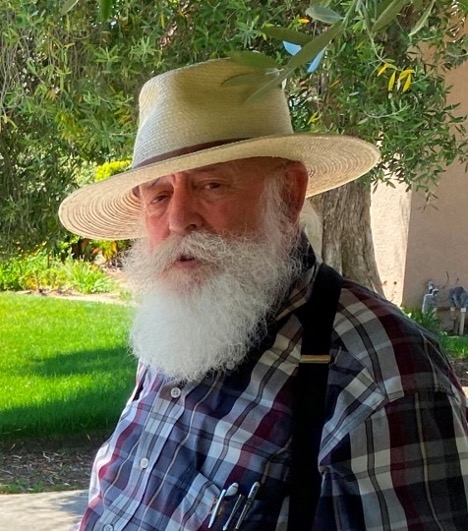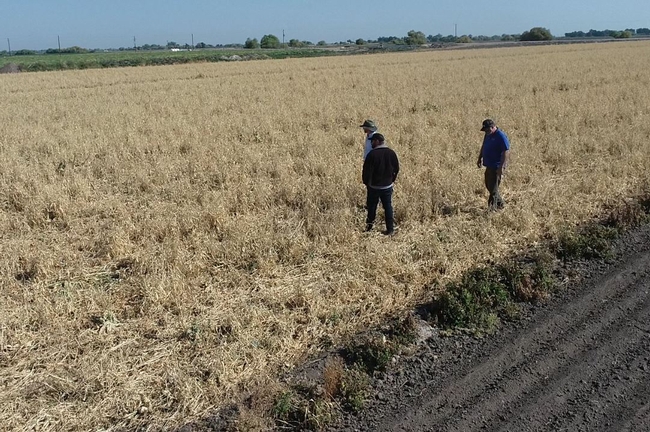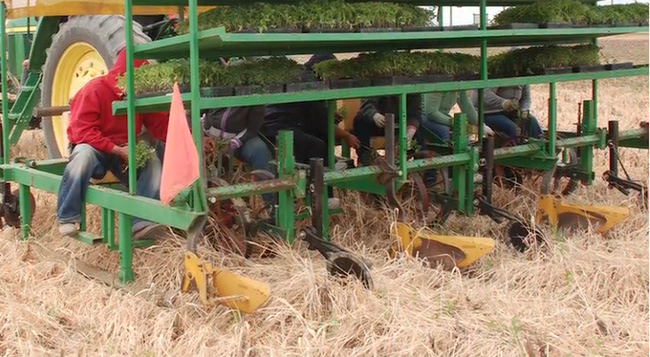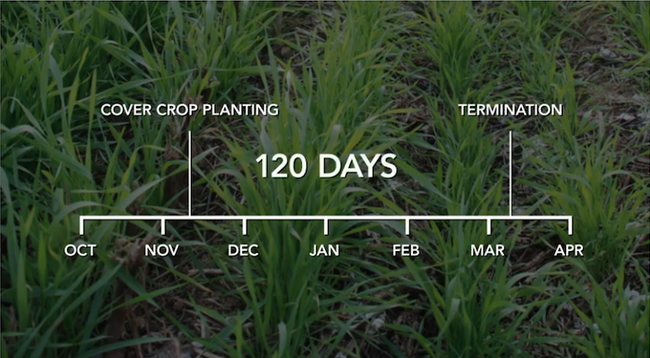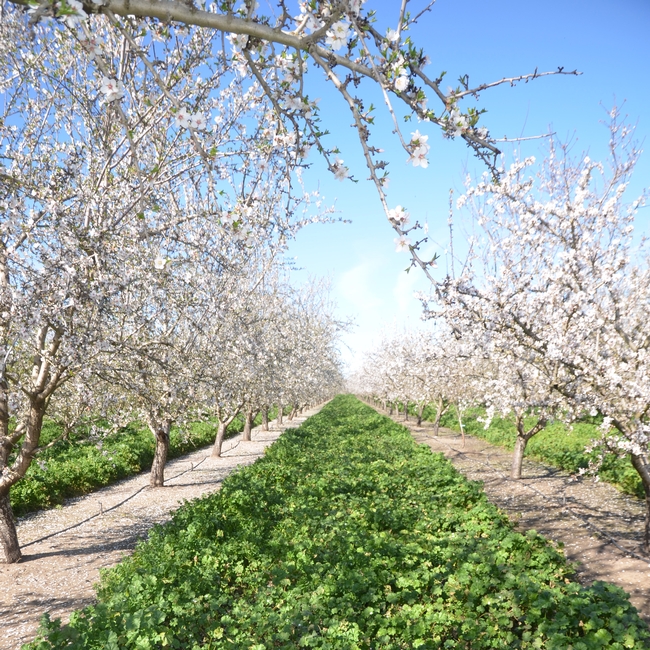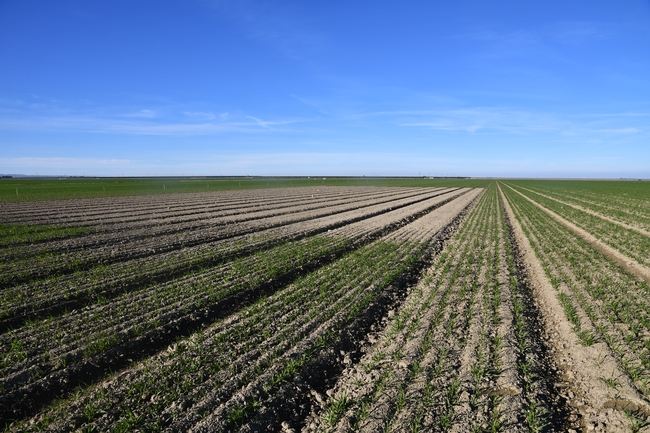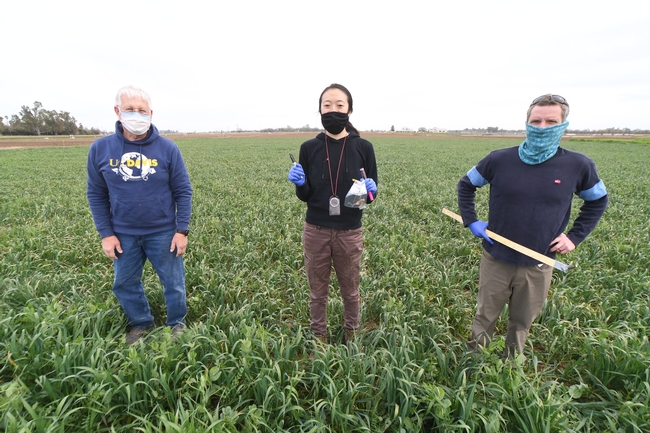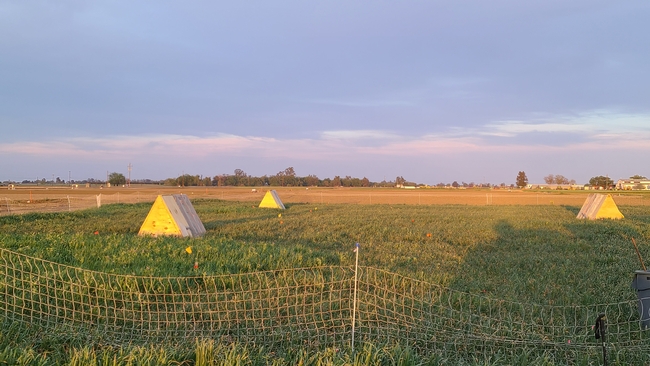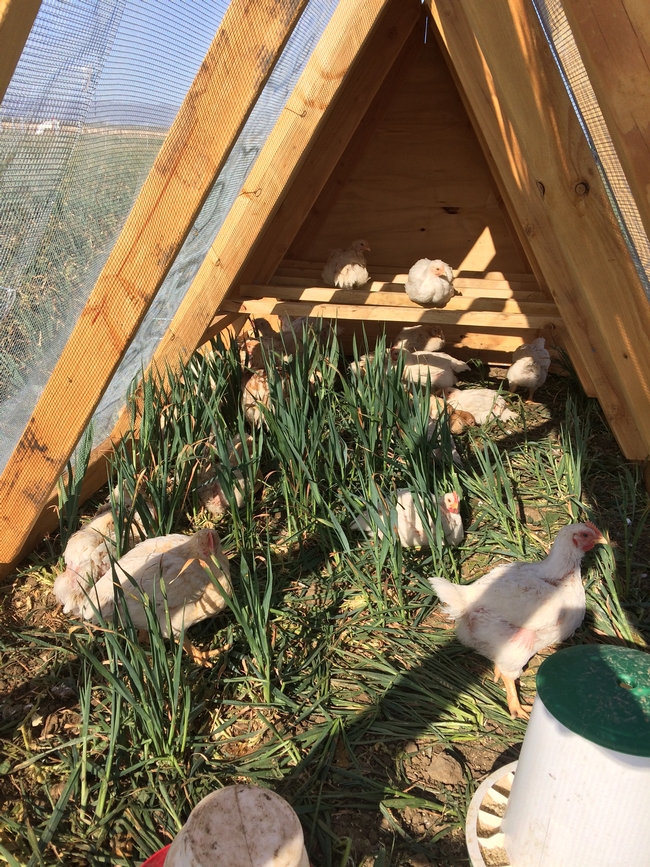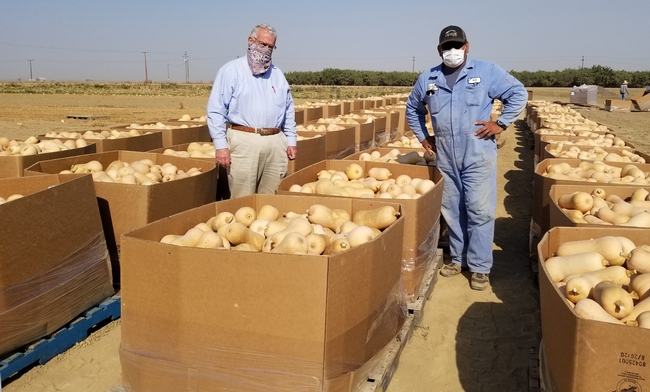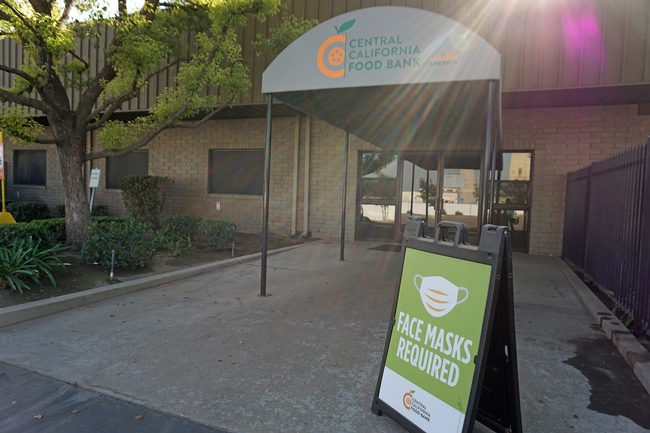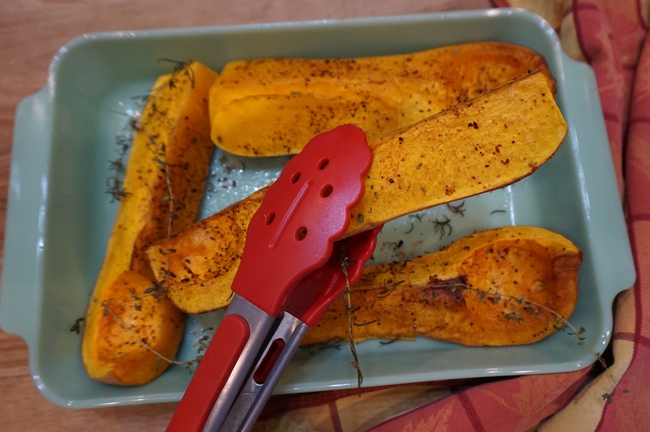Posts Tagged: Jeff Mitchell
Mitchell-led CASI honored by Soil and Water Conservation Society
Conservation Agriculture Systems Innovation has been named the 2022 recipient of the Conservation Innovation Award by the Soil and Water Conservation Society, an international organization based in Ankeny, Iowa.
“This is a very nice honor… and it has been achieved by, truly, the combined work and efforts of so many,” said Jeffrey P. Mitchell, UC Cooperative Extension specialist in UC Davis Department of Plant Sciences, who helped found CASI and has been instrumental in its leadership.
CASI, part of UC Agriculture and Natural Resources, started in 1998. It was formed by farmers, scientists and representatives of public agencies, private industry and environmental groups who aimed to develop knowledge and exchange information about the benefits of reducing tillage in agricultural lands.
Traditional practices such as tilling and plowing the land in preparation for crops are ingrained in agriculture. However, research has revealed that these practices cause soil erosion, dust and water run-off, and release greenhouse gases. In contrast, farmers and ranchers who have adopted the alternatives to tillage that CASI has been developing and evaluating see improved soil, better water infiltration and storage, less dust and lower costs, Mitchell said.
In the last 25 years, the no-till and low-till systems being explored by CASI have been widely adopted in much of the United States and in South America. But, in California's Central Valley, less than 1% of production acreage is farmed using conservation tillage. That's “largely because producers lack information, and successful examples of CT systems are only now being developed here,” CASI reported.
Now with more than 1,500 active members and affiliates, CASI conducts annual conferences to share research and the results of demonstration projects.
Mitchell's leadership of CASI praised
“Huge congratulations, Jeff, for your visionary and literally selfless leadership, always listening and learning, always humble. Thanks for taking us to new frontiers and possibilities of alternative futures. Thanks for showing us other ways to be a leader!!” – Kate Scow, UC Davis Department of Land, Air and Water Resources
“The team is special because everyone is sharing and learning as one. And, because your leadership has enabled us to all be more than the sum of the parts.” – Eric Kueneman, former global director of the United Nations Food and Agriculture Organization programs in Rome
“It was a pleasure to support the great work that this group does to change the farming paradigm in California.” – Cary Crum, California Ag Solutions
“Jeff is a modest person, but his achievements are numerous and span the gamut of extension, research and teaching. He has contributed enormously to our department through his innovative teaching, his inclusive extension work and his dynamic classroom teaching.” – Paul Gepts, UC Davis Department of Plant Sciences
The center's next project is to expand research and demonstration projects, acquire equipment, expand training and develop greater incentives for farmers to adopt conservation tillage in California.
Soil health in California cotton fields explored in video series
Over a century of growing cotton in California, scientists and farmers have learned how to better manage soil health. To share their collective knowledge, they have produced a series of videos about cultivating better soil health in cotton fields.
At its peak cotton production, California harvested as much as 1.6 million acres of cotton in the late 1970s to early 1980s. Due to water shortages, growers harvested less than 200,000 acres of cotton in 2020.
“Although cotton acreage in California has fallen off in recent years, some rather impressive advances in soil health management in San Joaquin Valley cotton production fields have been achieved in the past couple of years,” said Jeff Mitchell, UC Cooperative Extension specialist, who formed the California Conservation Agriculture Systems Innovation Center with growers and production consultants.
In partnership with the Soil Health Institute of Greensboro, NC, the Conservation Agriculture Systems Innovation Center has released a four-video series on soil health in California cotton production systems (YouTube links below).
“The series of four videos chronicles not only the history of advances in soil health management in San Joaquin Valley cotton systems, but also some major progress that stems from both long-term research and very recent farmer and private sector innovation with new production paradigms,” Mitchell said.
“San Joaquin Valley farmers have done some really impressive work in recent years to improve the ways that they care for the soil in their fields,” Mitchell said.
To improve soil health, growers try to minimize soil disturbance, enhance biological diversity, keep living roots in the soil and cover the soil with plants and plant residue. They experimented with no tillage and cover crops. Researchers found that cotton fields using no tillage and cover crops achieved a higher soil aggregate stability score than standard tillage with or without a cover crop and no till without a cover crop. In no-till fields with cover crops, water infiltrated the soil in seconds rather than minutes.
The soil health videos range in length from 10 minutes to 21 minutes.
The history video traces important contributors and breakthroughs during the 100-plus years that cotton has been grown in California.
The second video features progress at improving soil health made by Cary Crum, formerly of California Ag Solutions of Madera now with Agritechnovation, Inc., and cotton farmers he works with in the San Joaquin Valley.
The third video chronicles the goals and findings of the unique 22-year soil research study that has been underway in Five Points as one of the Soil Health Institute's national program of long-term North American soil health study sites. It shows what is possible when the core soil health principles are implemented consistently in the region.
The fourth video on the importance of soil aggregate stability shows how attention to the dedicated soil health management principles can improve soil structure and overall production efficiency.
One important lesson from the study is that growers must be patient, improvements in the soil occur gradually.
“We did not see changes in many soil health properties or indicators during the first eight or actually 10 years of our study,” Mitchell said.
Videos on soil health in California cotton fields:
Soil health management systems for California cotton: A brief history https://youtu.be/7DWIJ_3QIz8
Recent advances in soil health management in California cotton production systems https://youtu.be/tRWk-d9F1I8
Local research base for soil health management in California cotton production systems https://youtu.be/AdqnsicuGYo
Regenerating soil aggregate stability in California cotton production systems https://youtu.be/K2fsvPTmlF0
New cover crop research can help groundwater sustainability agencies plan
Cover crops seem to offset their water use by improving soil moisture retention
Cover crop research conducted by a team of university researchers is now helping to inform and shape policy to implement the Sustainable Groundwater Management Act (SGMA) in several San Joaquin Valley counties.
“The Madera County Regional Water Management Group appreciates continued scientific discussions on SGMA-related issues, and especially enjoyed hearing from researchers on cover crops,” said Tom Wheeler, chair of the Regional Water Management Group for Madera County and a Madera County supervisor. “This is work that should be helpful to growers as they evaluate cover crops as part of their sustainable future.”
To help protect groundwater resources over the long-term, groundwater sustainability agencies (GSAs) are developing groundwater sustainability plans for their local regions.
"Our findings suggest that cover crop water use is negligible in most water years and the long-term benefits can help GSAs meet their management goals,” said Alyssa DeVincentis, a former UC Davis Ph.D. student who worked on the project. “How cover crops impact soil moisture depends on species and management history, but generally soil moisture at the end of the winter season did not differ between fields with winter cover crops and clean cultivated soils."
From 2016 through 2019, UC Agriculture and Natural Resources researchers and their collaborators amassed very large data sets from almond orchard and tomato field sites located between Chico in Butte County and Arvin in Kern County. They used the data to quantify changes in soil water storage and evapotranspiration that occur under cover-cropped and bare fallow conditions during the winter cover crop growing period – about November to March.
The research team includes UC Cooperative Extension water specialists Daniele Zaccaria, Samuel Sandoval-Solis and Jeff Mitchell based at UC Davis; DeVincentis now of Vitidore, Inc.; and Anna Gomes, Ph.D. student at Stanford University.
The GSAs must first quantify the amount of water going into the groundwater bank through rainfall and surface water irrigation versus the amount of groundwater being removed at all farms within the GSA's jurisdiction.
“To do this, many local GSAs are turning to remote sensing and modeling of evapotranspiration, or ET, to provide data on the regional balance between groundwater depletions versus recharges,” Mitchell explained.
“Because winter cover crops may appear on remote sensing images as water-using vegetation, the sole use of model-driven data coming from satellites could become a disincentive to the practice being used.”
“This approach may not account for the important benefits that winter cover crops provide San Joaquin Valley farmers like Justin Wylie, a Madera County almond and pistachio grower who works with the research team,” Mitchell said. “He has experienced the benefits of winter cover crops firsthand, including increased water infiltration, habitat and carbon for soil organisms, and reduced water run-off.”
Cover crops grown during the winter may not use a lot of soil water because ET during this period tends to be low. They also provide shading and soil surface cooling, which help reduce soil evaporation. In addition, Mitchell said that cover crops can improve soil aggregation, pore space and soil moisture retention.
Together, cover crop benefits seem to offset or compensate for their actual water use during the winter.
“Because GSAs need reliable and accurate information related to this important issue and to possible shortcomings of relying solely on remote sensing as the way to go, our research has been particularly timely in the context of SGMA,” said Daniele Zaccaria, associate professor and water management specialist in UC Cooperative Extension at UC Davis.
A presentation about their cover crops research is available on YouTube at https://youtu.be/x3xQlZ9EdCk. The webinar is intended for water agency personnel, but the information is relevant to anyone who is interested in how cover crops may influence San Joaquin Valley cropping systems and the water cycle, Mitchell said.
A peer-reviewed article about this cover crop research, “ “Impacts of winter cover cropping on soil moisture and evapotranspiration in California's specialty crop fields may be minimal during winter months,” will appear in the first quarterly issue of California Agriculture in 2022.
Scientists to see whether chickens boost soil health, increase profits on organic vegetable farms
Historically, chickens were not a rare sight on farms, where they contributed to soil fertility as they freely pecked and scratched around vegetable gardens and crop land. Now, UC Cooperative Extension specialists have launched a research project to quantify the potential for chickens to be part of safe and sustainable commercial organic vegetable production.
“It's not a new idea. A lot of farmers are trying this kind of thing,” said UC Davis International Agriculture and Development graduate student Faye Duan, the project coordinator. “But there is currently little scientific information for using chickens on a bigger scale, especially in terms of food safety concerns.”
The California trial is part of a national effort to diversify organic vegetable farms with chickens. Last year, the USDA-funded study was launched by Iowa State University horticulture professor Ajay Nair. The project also includes UC Cooperative Extension specialists Maurice Pitesky and Jeff Mitchell, based at UC Davis, and University of Kentucky entomology professor David Gonthier.
In the trials, chickens are introduced as part of a rotation that includes cover crops and a variety of vegetable crops. In California, chickens were placed on research plots in April following a winter cover crop of vetch, peas, fava beans and oat grass.
“We don't let the chickens run around the field,” Duan said. “We keep them inside of chicken tractors to protect them from predators.”
Twenty-nine birds live in each 50-square-foot tractor, essentially a floorless chicken coop on wheels. The tractors, built by UC Davis students Mallory Phillips and Trevor Krivens, are wood frames covered with mesh and plywood. Each day, the tractors are moved to a different part of the plot, where the birds can graze on cover crop residue and deposit manure. Adjusting to the daily move took time, Duan said.
“The first day, the chickens were confused. We had to go slowly. It's a learning process for the chickens and us,” she said. “But now, the chickens are excited to move to a new spot where they have fresh food to graze on.”
After 24 days on pasture, the chickens will be removed, and become part of the project's meat study.
“We have broiler chickens that are raised for meat,” Duan said. “Some people believe chickens that graze and eat grass taste better and are more nutritious. It will be part of the study to look at the chicken's meat quality.”
Once the chickens have done their part on the research plots, vegetables are planted amid the leftover cover crop residue and chicken manure. This summer, the experiment in California will grow processing tomatoes. Subsequently, melons, eggplant, spinach and broccoli will be part of the vegetable rotation in California or the other states involved in the project. Other replications of the trial will have the chickens immediately follow the vegetable harvest so they can graze on the crop leftovers before the cover crop is planted. Comparing the soil health, fertilizer needs, chicken quality and other factors will help the scientists optimize the rotation.
“Vegetable yield will be an important indicator of success,” Duan said.
Soil samples will be tested to determine the presence or absence of Salmonella bacteria after the chickens have been removed, said Pitesky, a poultry specialist and a project lead. Salmonella is a bacterium that can be part of poultry's microbiome. If the bacteria contaminates human food, it can cause illness.
“Since Salmonella lives in the chicken gastrointestinal system, when it gets into the soil, it will eventually be out-competed by bacteria more adapted to soil than the gut of a chicken,” Pitesky said. “There are many different types of Salmonella, and only a select few found in birds are the ones that are harmful to humans. Nevertheless, it is very important to test and use various practices to mitigate the presence of Salmonella on land that will be used for crop production following poultry.”
Early results of soil tests in Iowa and Kentucky detected Salmonella in the soil where chickens grazed, however, the bacteria disappeared very quickly.
Farmer’s inspiration leads to large squash donation to Central California Food Bank
West Side farmer John Diener had flash of inspiration. Why not plant butternut squash?
Diener is a long-time research cooperator with UC Cooperative Extension specialist Jeff Mitchell, who has studied innovative, sustainable farming practices for 21 years at the UC West Side Research and Extension Center under four different treatments: no-till plus cover crops, no-till with no cover crops, conventionally tilled with cover crops and conventionally tilled without cover crops.
Since it was established, the research plots have been managed in an annual rotation of cotton, processing tomatoes and, more recently, sorghum, garbanzo beans and melons. When trying to decide what crop to bring into the rotation for 2020, Diener thought of butternut squash, a relatively large, thick-skinned squash that has little pest and disease problems and a long-shelf life. He suggested the squash could be donated to the Central California Food Bank and made available to local families in time for Thanksgiving and Christmas.
CCFB provides food to more than 220 agencies in Fresno, Madera, Kings, Kern and Tulare counties, serving more than 280,000 people each month. Last year, CCFB supplied over 40 million pounds of food in all.
Diener arranged for butternut squash seed to be donated by David Bodine of AgSeeds. He generously paid for several days of labor to harvest the crop. Diener contacted family friend Joan Minasian, who serves on the Food Bank board, to make arrangements for delivering 101 bins of squash – more than 70,000 pounds – to the food bank's Fresno distribution center.
“The Central Valley Food Bank is working on diversifying the food we offer in meal boxes and distributions,” Minasian said. “I'm really proud of the food bank's efforts to increase healthy foods. We're always looking for farmers to partner with.”
Butternut squash, a winter squash, has a 90-day shelf life without refrigeration. It is grown in the summer; the name is derived from the fact that the mature vegetable can be stored for winter eating.
In addition to supporting farmers with research and advice, UC Cooperative Extension offers nutrition education programs to low-income Californians. Deepa Srivastava – UCCE nutrition, family and consumer sciences advisor for Kings and Tulare counties – manages two programs that extend information to families on healthy eating, food safety, food resource management, gardening, physical activity and youth engagement.
Srivastava said butternut squash is a nutritious addition to family diets. The vegetable is a good source of vitamin A and vitamin C, and also supplies vitamin B-6, protein, fiber, magnesium, potassium and iron.
The squash's buff exterior protects golden flesh that is nutty and sweet. It can be baked, boiled or grilled whole or chopped. Cooked squash can be pureed for soup or baby food, added to casseroles, pies, salads and stuffing. The cooked flesh adds beautiful fall color to everyday meals or holiday spreads.
One easy way to prepare butternut squash is roasting in the oven. Preheat the oven at 350 degrees. Carefully cut the squash in half and scrape out seeds and strings with a spoon. Place cut side up in an oven-safe pan, then brush the flesh lightly with olive oil. Season to taste with salt, pepper, cayenne pepper, fresh or dried herbs and spices. Bake for one hour, or until it can be easily pierced with a fork.


